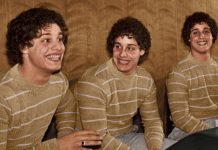How Andy Serkis became Caesar in ‘War for the Planet of the Apes’
By Ed Symkus
Andy Serkis has become, in two-and-a-half decades of stage, television, and film work, one of the world’s great unrecognized actors. Taking cues from the silent movie star Lon Chaney, whose innovative use of makeup in films including “The Hunchback of Notre Dame” and “The Phantom of the Opera” earned him the moniker “the man of a thousand faces,” Serkis is best known for donning a motion-capture suit and digitally disappearing into his performances as Gollum, King Kong, and Caesar, the simian leader in the reboot of the “Planet of the Apes” films. The newest is “War for the Planet of the Apes.”
Serkis, 53, a longtime Londoner, attended Lancaster University to study visual art, but was sidelined when, required to add a subsidiary course, he checked out the theater department. The plan was to design sets and posters, but he took part in a few student productions and, as he puts it, “by the end of my first year completely fell in love with acting.”
Post-college, he joined a nearby repertory theater, acting in everything from Shakespeare to Brecht to David Hare. “I was rehearsing during the day, performing at night, honing my craft as an actor,” he said. That led to a stint at London’s Royal Court Theatre where, in 1995, Serkis was in the original production of Jez Butterworth’s rock ’n’ roll thriller, “Mojo.” Film director Mike Leigh caught the show one night and, soon after, gave him roles in “Career Girls” and “Topsy-Turvy.”
Lots of small parts in films, as well as regular work in series television followed, but it was Serkis’s voice that grabbed the interest of director Peter Jackson when he was prepping his “Lord of the Rings” trilogy. By telephone from Austin, Texas, where he was promoting “War for the Planet of the Apes,” Serkis spoke in tones much deeper than Gollum’s about how that franchise shifted his career in an unexpected direction.

20th Century Fox
Andy Serkis on the set of the film “War for the Planet of the Apes.”
Q. When was the first time you heard the term “motion capture”?
A. My agent told me they were making “The Lord of the Rings” down in New Zealand and they wanted an actor to do the voice of a digital character. I said, “Look, it’s ‘The Lord of the Rings,’ there must be a dozen really good roles in that. Can you get me up for something decent?” He said, “Well, it’s Gollum.” So, I did the audition, and I got the re-call, and Pete came to London, we met, and he said, “We’re thinking of using this technology, which is in its very early days, called motion capture.” Now, in those days, actors playing opposite a [computer-generated] character had to imagine the whole life of that character by working with a tennis ball. Pete said, “I want you to be on set so the actors playing Samwise Gamgee and Frodo Baggins don’t have to imagine Gollum. You will be Gollum. But because of the way we designed him, it’s impossible for an actor to wear makeup. So, would you be interested in using this technology?” That’s how it all started for me.
Q. That trilogy started filming in 1999. How has the motion-capture technology changed since then?
A. I’m still wearing the suit with the markers; that hasn’t changed. But what has changed is that you don’t have to re-shoot it. In “Lord of the Rings,” after having shot on location or on a set, I would have to go back to a motion-capture stage and shoot the scene again to “capture.” The big change went from having to do that to being able to shoot on location only once. That really started with “Rise of the Planet of the Apes.”
Q. In the “Apes” series, you’ve played Caesar from infancy to adulthood. Could you sum up the emotional changes he’s gone through?
A. Caesar is a young chimpanzee who has been the recipient of an enhanced intelligence drug. He was brought up and loved by human beings. But at the same time this sped-up intelligence made him something like a highly gifted child, like a child who could do complicated mathematical problems or play a Beethoven concerto at the age of 3. That made him kind of an outsider character who believes himself a human in an ape’s skin.

20th Century Fox
Andy Serkis as Caesar (with Devyn Dalton as Cornelius) in “War for the Planet of the Apes.”










